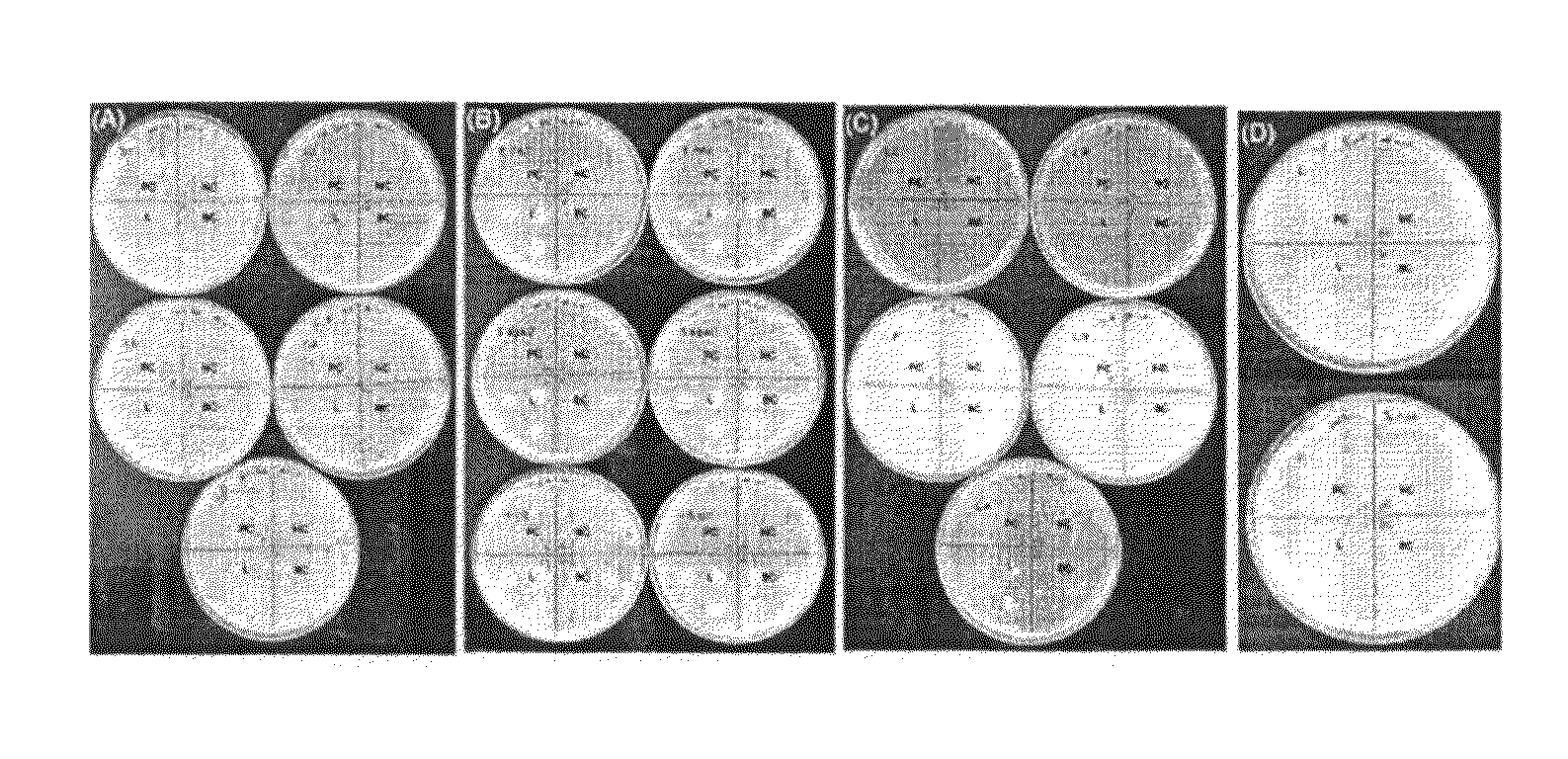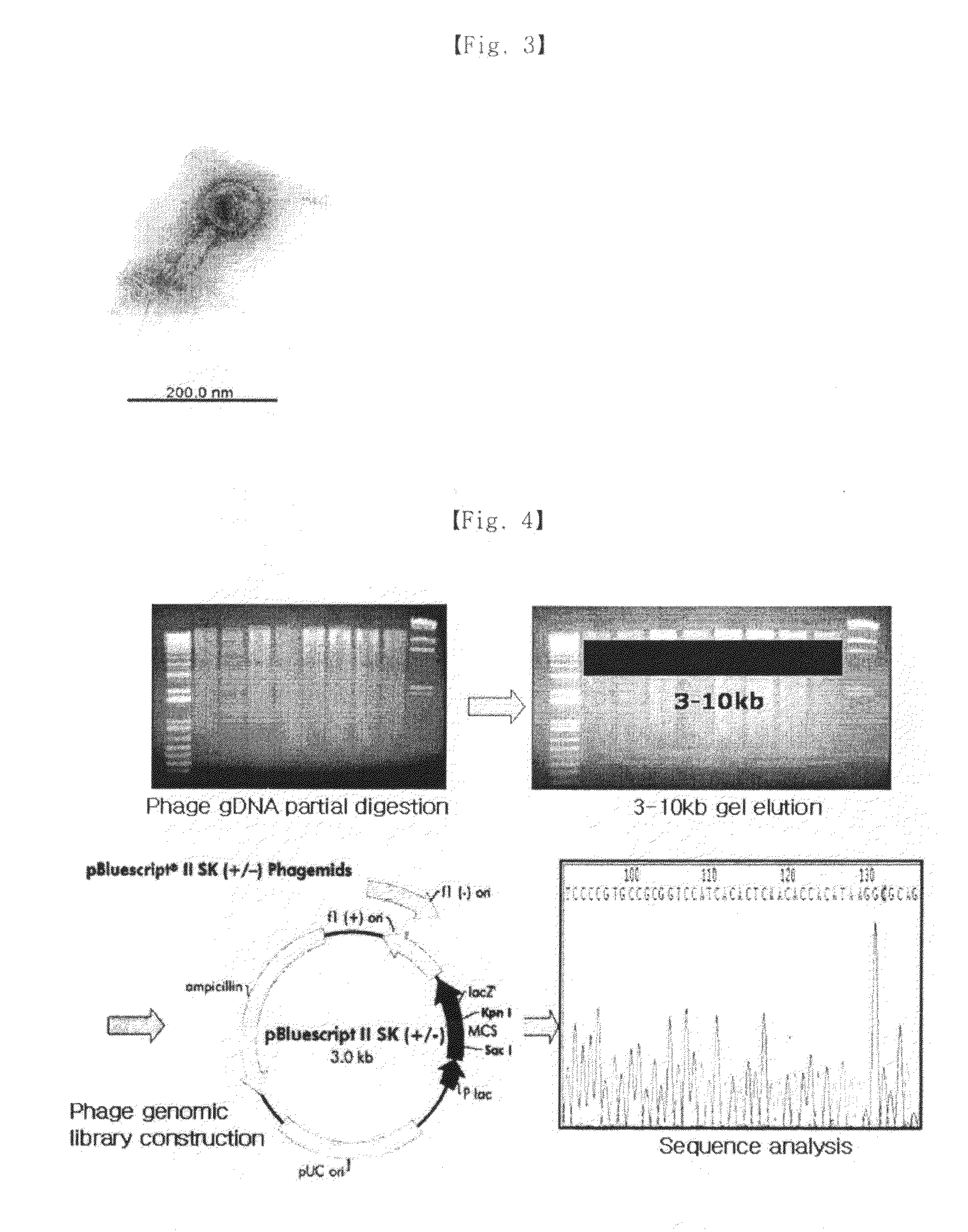Antimicrobial protein specific to Staphylococcus aureus
a staphylococcus, antimicrobial technology, applied in the direction of peptides, enzymology, drug compositions, etc., can solve the problems of antibiotic-based treatment having a serious problem, limited research on bacteriophages, and great shock to those in medical field, and achieves high specificity, less side effects, and highly valuable antibiotics
- Summary
- Abstract
- Description
- Claims
- Application Information
AI Technical Summary
Benefits of technology
Problems solved by technology
Method used
Image
Examples
example 2
Genetic Characteristics of the Staphylococcus aureus Specific Bacteriophage Isolated
[0059]The gene of bacteriophage isolated was sequenced. To do so, the genome of the bacteriophage was first extracted by the conventional method and its genetic characteristics were examined.
[0060]Particularly, 200 ml of TSB (tryptic soy broth) medium (casein digest, 17 g / l; soybean digest, 3 g / l; dextrose, 2.5 g / l; NaCl, 5 g / l; dipotassium phosphate, 2.5 g / l), 50 ml of Staphylococcus aureus culture broth (OD600=1) and 1 ml of filtered bacteriophage solution at the concentration of 108 pfu / ml were added into a 1 l flask, followed by shaking-culture at 37° C. for 3-4 hours. Then, lysis of Staphylococcus aureus was observed. After confirming lysis, the culture broth was filtered with a 0.45 μm filter. After filtration, 20% polyethylene glycol 8000 / 2.5 M NaCl aqueous solution was added to the filtrate by the volume of ⅙ of the total volume of the filtrate, and the mixture was standing at 4° C. for overn...
example 3
Cloning of the Gene Encoding the Lytic Protein
[0065]CHAP region which is a part of lytic protein involved in lysis was identified by ORF analysis in example 2 (FIG. 8). CHAP in ORF 5 and ORF 33 is known to be a region of lytic protein involved in lysis. To identify the location of the lysis-related gene on the genome, nucleotide sequence of the lysis-related gene was compared with the nucleotide sequences of bacteriophage G1 and Staphylococcus aureus bacteriophage K (GenBank accession number of the nucleotide sequence of bacteriophage G1 is AY954969, and GenBank accession number of the nucleotide sequence of Staphylococcus aureus bacteriophage K is AY176327), considering the isolated bacteriophage had a significant homology with those.
[0066]As a result, in the whole nucleotide sequence of the genome of bacteriophage G1, ORF042 comprising nucleotide (nt) 132132-132935 and ORF083 comprising nt 132935-133438 were confirmed to be the lysis-related genes. In the case of Staphylococcus au...
example 4
Sequence analysis of CHAP region
[0070]Sequencing the cloned gene in the recombinant plasmid selected in Example 4 was performed by the conventional method. M13 forward primer and M13 reverse primer were used for the sequencing. The identified sequence was further analyzed by NCBI Blast program and as a result, the cloned gene was confirmed as a part of lysis-related gene (FIG. 9). For obtaining more information about the nucleotide sequence of the gene involved in lysis, new primers were constructed, with which sequencing was performed again. These primers are shown in Table 3.
[0071]
TABLE 3PrimerNucleotide sequenceSEQ-1SEQ. ID. NO: 5SEQ-2SEQ. ID. NO: 6SEQ-3SEQ. ID. NO: 7
[0072]The nucleotide sequence of the gene involved in lysis (CHAP) identified from the additional sequencing was compared with the nucleotide sequence of the bacteriophage G1, which was confirmed to have the highest sequence similarity with the sequence of the bacteriophage isolated herein, by using Vector NTI AlignX...
PUM
| Property | Measurement | Unit |
|---|---|---|
| concentration | aaaaa | aaaaa |
| total volume | aaaaa | aaaaa |
| pH | aaaaa | aaaaa |
Abstract
Description
Claims
Application Information
 Login to View More
Login to View More - R&D
- Intellectual Property
- Life Sciences
- Materials
- Tech Scout
- Unparalleled Data Quality
- Higher Quality Content
- 60% Fewer Hallucinations
Browse by: Latest US Patents, China's latest patents, Technical Efficacy Thesaurus, Application Domain, Technology Topic, Popular Technical Reports.
© 2025 PatSnap. All rights reserved.Legal|Privacy policy|Modern Slavery Act Transparency Statement|Sitemap|About US| Contact US: help@patsnap.com



